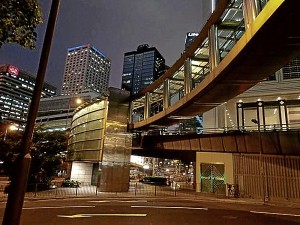Green transport

HONG KONG elevated walkways improve circulation routes. They are connected to outdoor elevator walkways in some parts, and integrated with retail outlets. A.P de Jesus & Associates—Green Architecture
Hong Kong is a popular summer destination. The spirit of Hong Kong coming from emigrants determined to work and sustain a better quality of life is what made it a major financial center.
Hong Kong is admirable in the sense that only 20 percent of its transport energy is used by private cars. Its per capita energy usage is only about one-fourth of Singapore. Hong Kong’s mass transit system daily ridership amounts to a third of the population.
Nearly half of its land area which is almost double that of our National Capital Region is covered by country parks. The high-rise jungle of this subtropical city has been using the catch-phrase environmental sustainability since the late 1990s.
Public transport systems
Over 10 million passenger journeys are made daily on public transport systems including high-capacity railways, trams, buses and taxis. There are 280 licensed public transport vehicles for every kilometer of road, and some 500 bus routes in operation. Hong Kong’s MTR or Mass Transit Railway provides more than 2 million journeys a day for its 7 million population.
Article continues after this advertisementIt is no wonder that energy used for transport in Hong Kong represents 35 percent of all energy used and is the highest single sector usage there.
Article continues after this advertisementTransport fares are low because of the volume of passenger traffic. Also, major infrastructure providers are given land rights over their stations for development.
Aside from the public transport system, city areas in Hong Kong have elevated pedestrian walkways that improve circulation routes. They are connected to outdoor elevator walkways in some parts, and integrated with retail outlets. These walkways extend into neighborhoods and revitalize residential areas.
Other mass transport systems
Singapore’s mass transit system daily ridership is equal to half of the city state’s total population.
Jakarta has dedicated lanes for its Bus Rapid Transit System. Bangkok and Kuala Lumpur mass transit system ridership is similar to Manila’s, which is below 10 percent of population.
It is notable that Hong Kong and Kuala Lumpur motorized travel is around 20 percent compared to Manila’s 60 percent.
Population
Manila’s population is growing just like any Asian city. Half of air travel today is in Asia. The economy in Asia is driven by consumption because of our healthy population growth.
The fact that one-third of Philippine population is below 14 years of age is a plus factor, even if our total fertility rate has declined from 6 children in 1975 to 3 today. At that rate we will be at replacement level in 2025.
Total fertility rate of 2.1 is equal to replacement level. That means a woman of reproductive age having 2.1 children will not contribute to population growth because two children will only replace their parents when they die. Point one represents women with no children. This is without any legal population control policy, yet our number of children per family is visibly going down.
Metro Manila’s land area of 620 square kilometers and 11 million inhabitants, has a population density similar to Shanghai, Taipei, Seoul, Jakarta. Hong Kong has only 6,500/sq km population density.
The Philippines’ second most densely populated region Calabarzon (Cavite, Laguna, Batangas, Rizal and Quezon) has now 12 million inhabitants in the region’s land area of 16,600 sq km. Manila can decongest with a good mass transport system.
This will help to bring down carbon emissions of 39 percent from transport.
For comments or inquiries, email [email protected]